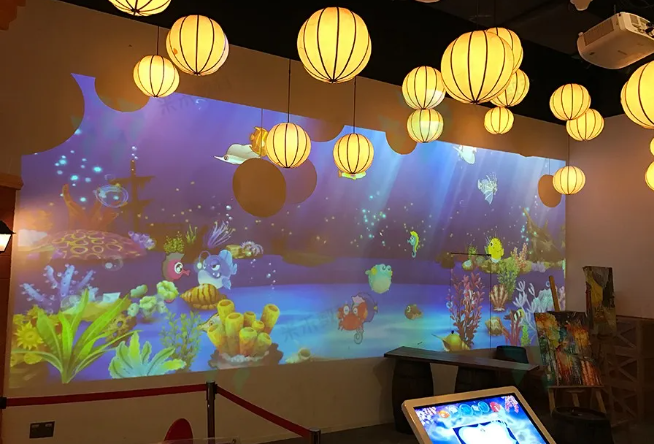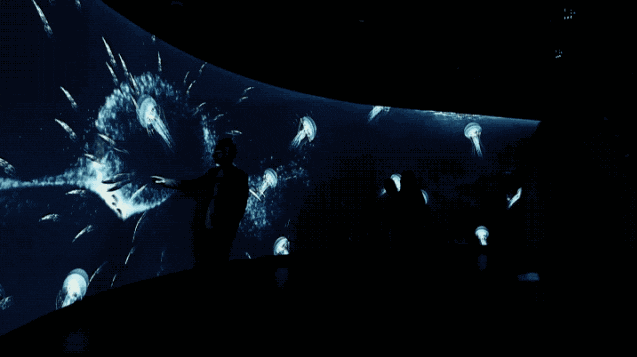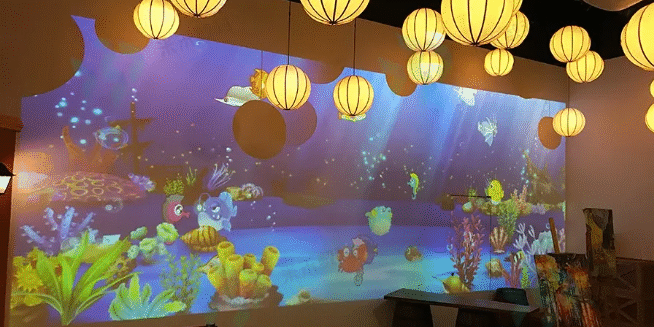The Rise of Interactive Wall Projection in Exhibition Spaces
In today’s digital era, multimedia exhibition halls are transforming from static displays into immersive storytelling environments.
At the heart of this evolution lies interactive wall projection — a technology that turns ordinary walls into dynamic canvases capable of reacting to audience movements and touch.
By integrating visual art, motion sensing, and projection mapping, exhibition designers can create spaces that attract attention, spark curiosity, and deepen audience engagement.
CPJROBOT, a manufacturer specializing in POE interactive LiDAR sensors and reception & navigation robots, plays a key role in enabling these intelligent, touch-free experiences.

1. Conductive Ink Interactive Wall
How It Works
A conductive ink interactive wall combines printed artwork with motion or touch sensing.
When visitors touch or approach the printed surface, sensors detect the interaction and trigger projections of images, sounds, or animations that appear to “come alive” from the wall.
Why It Stands Out
- Seamlessly blends physical art with digital media
- Provides a highly tactile and magical experience for visitors
- Ideal for art exhibitions, corporate lobbies, and cultural displays
With CPJROBOT’s POE LiDAR sensors, the wall can accurately sense gestures without physical contact, delivering high precision, low latency, and auto-calibrated responses that make every interaction feel natural.
2. Interactive Wall Graffiti
How It Works
Interactive wall graffiti allows visitors to create digital art in real time.
Guests draw using a touch screen, stylus, or digital tablet, and their creations are projected instantly onto the wall — often animated or reacting to movement.
Why It’s Popular
- Encourages creativity and audience participation
- Supports group interaction — ideal for kids’ zones, museums, or innovation centers
- Provides a strong shareable moment for social media engagement
By integrating LiDAR gesture recognition, CPJROBOT’s system can extend interactivity beyond the touch screen — enabling visitors to “swipe” or “paint” in mid-air, turning creativity into an immersive group experience.

3. Body-Shadow Particle Interaction
How It Works
This system uses depth-sensing cameras or LiDAR sensors to detect the audience’s body shape and movement in front of the wall.
As people move, their silhouette transforms into particles, light trails, or floating effects, responding instantly to their actions.

Why Audiences Love It
- Highly visual and emotionally engaging
- Creates a sense of presence and wonder
- Perfect for entrances, digital art corridors, or interactive showpieces
CPJROBOT POE LiDAR excels in this type of installation.
Its wide detection angle (270° or 360°) and multi-sensor cascading capability ensure seamless coverage for large-scale or curved walls — without blind spots or manual calibration.
Applications Across Exhibition Halls
Interactive wall projection systems are now widely used in:
- Science and Technology Museums – Educational demonstrations and hands-on learning
- Corporate Experience Centers – Product storytelling and brand interaction
- Art Galleries and Cultural Spaces – Immersive visual storytelling
- Retail and Shopping Malls – Eye-catching customer engagement areas
- Public Spaces and Theme Pavilions – Interactive installations that attract crowds
These installations not only enhance the visual appeal of exhibitions but also extend visitor dwell time and increase emotional connection with the displayed content.
Why Choose CPJROBOT for Interactive Projection Projects
CPJROBOT provides end-to-end solutions for multimedia spaces, including:
Advanced POE LiDAR Sensors
- Multi-touch radar interaction
- Plug-and-play PoE power and data through a single cable
- No manual calibration required
- Stable operation under bright light or complex environments
Reception & Navigation Robots
- Designed for exhibition halls, airports, hotels, and corporate spaces
- Support voice interaction, facial recognition, and auto navigation
- Seamlessly integrate with interactive wall systems to guide and welcome visitors
Together, these technologies form the backbone of smart exhibition spaces that combine automation, interactivity, and immersive design.
Frequently Asked Questions (FAQ)
Q1: What makes LiDAR better than infrared or camera sensors for wall projection?
A: LiDAR measures distance using light pulses, providing centimeter-level accuracy and stable performance in any lighting conditions — perfect for exhibition halls where brightness changes frequently.
Q2: Can CPJROBOT LiDAR support large exhibition walls?
A: Yes. Multiple LiDAR sensors can be cascaded to cover wide or curved walls seamlessly, maintaining precise tracking across all zones.
Q3: Does installation require manual alignment?
A: No. CPJROBOT’s POE LiDAR features automatic calibration, drastically reducing setup time and maintenance costs.
Q4: Can I combine LiDAR interaction with robots in one exhibition?
A: Absolutely. CPJROBOT’s navigation robots can interact with the same LiDAR network, offering unified control and synchronized visitor engagement.
Conclusion
Interactive wall projection has become an essential part of modern exhibition design — merging technology, art, and emotion into one dynamic experience.
From conductive ink walls to body-shadow particle displays, each form enhances storytelling and transforms how audiences connect with content.
With CPJROBOT’s POE LiDAR and reception robot solutions, exhibition halls can easily achieve multi-touch interaction, effortless installation, and intelligent visitor engagement — creating spaces that truly come alive.







